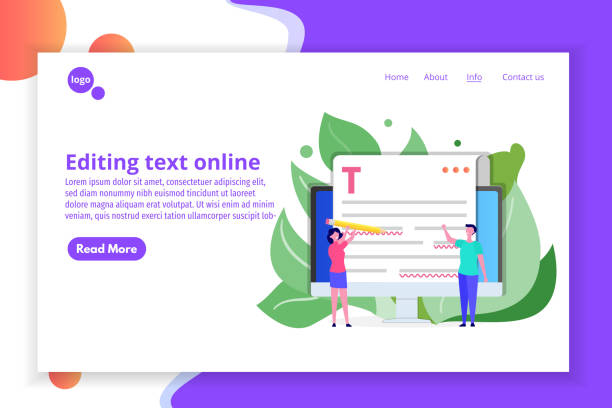Why Responsive Web Design is No Longer an Option, But a Necessity

In today’s world, where technology is advancing at a dizzying pace and users access the internet from various devices, the concept of #Responsive_Web_Design (or Responsive Website Design) has transformed from a competitive advantage into an undeniable necessity.
This approach in web design ensures that your website displays optimally on any screen size, from small smartphones to tablets, laptops, and even smart TVs.
It’s no longer possible to provide a seamless and optimized experience to users by having separate versions for mobile and desktop; the variety of devices is far too vast to create a dedicated version for each.
Responsive web design not only improves user experience but also plays a vital role in Search Engine Optimization (SEO).
Search engines like Google rank mobile-optimized websites higher in search results.
This means that if your website lacks responsive website design capabilities, you might lose a significant portion of organic traffic.
Indeed, this topic is a fundamental lesson for anyone intending to enter the digital world, and understanding this necessity is crucial for an effective web presence.
Tired of losing customers due to poor e-commerce website design? With Rasaweb, solve this problem forever!
✅ Increase sales and visitor-to-customer conversion rates
✅ Smooth and engaging user experience for your customers⚡ Get Free Consultation
Fundamental Principles of Responsive Design: Understanding How It Works

To understand the workings of responsive website design more deeply, it’s essential to become familiar with its three main pillars: Fluid Grids, Flexible Images, and Media Queries.
Fluid Grids mean that your website’s layout is designed based on percentages, not fixed pixels.
This approach allows website content to dynamically adjust its size to the screen width.
Instead of defining fixed widths for columns, percentages like 33% or 50% are used, which causes the layout to automatically stretch or compress.
Flexible Images also work similarly to fluid grids; meaning images must also be able to adjust their size according to the available space to prevent layout breakage or horizontal scrolling.
This is often done by setting the property max-width: 100%; for images in CSS.
Media Queries are the beating heart of responsive website design.
These CSS commands allow developers to apply different style rules based on device characteristics such as screen width, height, orientation (portrait or landscape), and even resolution.
For example, you can define rules that make the website’s layout single-column on mobile devices, while it’s three-column on desktop.
This specialized capability enables us to have precise control over how content is displayed on different devices and to optimize the user experience.
Understanding these principles is the first step in successful responsive website design implementation, and without it, achieving a truly compatible website across all devices will be almost impossible.
Modern Tools and Frameworks for Responsive Website Design

In the process of implementing responsive website design, numerous tools and frameworks exist that simplify the work for developers and accelerate the workflow.
These tools, by providing pre-built components and ready-made grid systems, help designers and developers create responsive websites with less coding and greater efficiency.
One of the most popular and well-known frameworks is Bootstrap, which offers a comprehensive collection of CSS and JavaScript for building responsive and mobile-first websites.
Bootstrap, with its 12-column grid system, easily facilitates the design of complex layouts.
Another framework that has recently gained significant popularity is Tailwind CSS.
Unlike Bootstrap, which provides ready-made components, Tailwind is a Utility-First framework.
This means you design your website using small, atomic classes (like flex, md:w-1/2, p-4).
This approach gives you very high flexibility and prevents the generation of unnecessary CSS code.
In addition to frameworks, core CSS technologies like Flexbox and CSS Grid Layout are also powerful tools for creating complex and responsive layouts.
Flexbox is highly suitable for designing one-dimensional layouts (e.g., a single row or a single column), and Grid for two-dimensional layouts (rows and columns).
Using these tools is a practical and specialized guide for any developer who wants to have a powerful and efficient presence in today’s web world.
These tools are so important that knowing and mastering them can make a significant difference in the quality and speed of responsive website design projects.
| Feature | Bootstrap | Tailwind CSS | CSS Grid/Flexbox (Native) |
|---|---|---|---|
| Primary Approach | Component-First | Utility-First | Native CSS Rules |
| Initial Development Speed | High (with ready-made components) | Medium (requires learning classes) | Medium to High (requires deep understanding of CSS) |
| Final CSS File Size | Larger (unless unnecessary modules are removed) | Smaller (with PurgeCSS) | Smallest (only what’s needed) |
| Flexibility | More limited (for deep customization) | High (full control over styling) | Highest (full control over layout) |
| Learning Curve | Medium (familiarity with classes) | Medium to High (learning a large number of classes) | Medium to High (complex concepts) |
| Ideal Use Case | Quick projects, MVPs, standard templates | Projects requiring high customization | Precise control over layout, reduced framework dependency |
User Experience (UX) and Responsive Design: An Inseparable Link

Responsive website design and User Experience (UX) are two sides of the same coin.
The ultimate goal of any successful web design is to provide a satisfying and seamless experience to the user, regardless of the device they are using.
Responsive website design directly contributes to improving UX by ensuring that content is displayed correctly and the usability of the website is maintained across all devices.
Imagine a user browsing your website on their smartphone; if the website is not responsive, they will have to zoom in to read texts, painstakingly aim to click buttons, or endure annoying horizontal scrolls to find different sections.
This experience is not only frustrating but is also likely to lead to the user leaving the website.
A website with responsive website design automatically adjusts the layout, font sizes, images, and navigation elements for the user’s device.
This means no need for zooming, easily clickable buttons, and navigation menus logically organized for smaller screens (like a hamburger menu).
This level of ease of use significantly increases user satisfaction.
Furthermore, website accessibility is also improved with responsive website design.
Users with special needs, such as individuals with visual impairments who use magnification, benefit from flexible layouts that seamlessly adapt to their zoom settings.
Ultimately, responsive website design is an analytical approach to ensuring that the user experience is integrated, enjoyable, and frictionless, which is vital for the success of any website.
Are you dissatisfied with the low visitor-to-customer conversion rate on your e-commerce site?
Solve this problem forever with professional e-commerce website design by Rasaweb!
✅ Increase visitor-to-customer conversion rate
✅ Create an excellent user experience and build customer trust
⚡ Get Free Consultation
Optimizing Speed and Performance in Responsive Design: Challenges and Solutions

While responsive website design offers countless advantages, it also brings challenges in the realm of speed and performance optimization, neglecting which can disrupt the user experience.
One of the biggest challenges is managing the size and dimensions of images.
If a high-quality image is loaded for desktop and then merely scaled down for mobile, the original large file still needs to be downloaded, which can severely reduce loading speed.
The solution to this problem is using Responsive Images with the <picture> tag or the srcset attribute, which allows the browser to select and load the appropriate image for the screen size.
Another challenge is excessive CSS and JavaScript loading.
If all the website’s CSS and JavaScript code is loaded for every screen size, even if not necessary for that specific size, loading time increases.
The solution is to use smart Media Queries for conditional CSS loading and techniques such as Lazy Loading for images and videos, and Code Splitting for JavaScript.
These techniques mean loading content and code only when needed and when the user scrolls to that part of the page.
Code Minification and file Concatenation for CSS and JavaScript, using a CDN (Content Delivery Network) for faster content delivery, and file Compression (Gzip Compression) are also other vital solutions for improving the speed of a responsive website.
This topic is highly specialized and requires careful attention to ensure your website is not only beautiful but also fast and efficient, serving as a practical guide for developers.
Contentious Content: Is Responsive Design Always the Best Solution?

Despite all the advantages and numerous recommendations for using responsive website design, a deeper question arises: Is this approach always the best and only solution? The answer to this question is a bit more complex than a simple “yes” or “no” and has become a contentious topic in the web world.
In most cases, responsive website design is the superior choice; however, in specific scenarios, other approaches might be considered.
For example, for websites that offer a completely different user experience on desktop and mobile, or websites with very heavy and complex data that cannot be rendered responsively without sacrificing performance, alternative approaches such as “Adaptive Design” or even having separate versions (though less recommended) might be proposed.
In adaptive design, instead of a fluid layout, several fixed layouts are designed for specific breakpoints.
This approach can offer more control over the user experience on each device but requires designing and maintaining multiple layouts, which increases complexity.
Also, in some highly complex and data-driven web applications that require a very specific and optimized user interface for each device, developing native mobile applications alongside a desktop website might be a more suitable solution.
This is an analytical discussion that shows even the best solution is not always absolute, and depending on the project’s needs and goals, flexibility in choosing the design approach is necessary.
Nevertheless, it must be emphasized that for the vast majority of websites and web applications, responsive website design remains the best and most practical option.
The Future of Responsive Website Design with AI and New Technologies

The future of responsive website design extends beyond current principles and, with the integration of emerging technologies like Artificial Intelligence (AI) and Machine Learning (ML), is moving towards unprecedented automation and optimizations.
AI can dynamically and in real-time customize layouts and content for each user by analyzing user behavior, device settings, and even personal preferences.
This capability means an incredibly personalized user experience that goes beyond mere responsiveness.
AI-powered design tools can automatically generate responsive prototypes, identify design weaknesses, and even suggest optimized code for performance.
This is big news for developers and designers, as it can significantly accelerate the design process.
In addition to AI, technologies like WebAssembly and Progressive Web Apps (PWAs) will also play a crucial role in the evolution of responsive website design.
WebAssembly allows developers to execute high-performance code from languages like C++ and Rust directly in the browser, which helps in building extremely powerful and complex web applications that perform similarly to native applications.
PWAs combine responsive websites with native app capabilities such as offline functionality, push notifications, and device hardware access.
These advancements represent an exciting analytical outlook for the future of web design, where websites will not only be responsive but also smarter, faster, and increasingly similar to native applications, thereby doubling the need for responsive website design.
| Technology | Description | Impact on Responsive Design |
|---|---|---|
| Artificial Intelligence (AI) in Design | Using AI algorithms to automate design processes, generate layouts, and optimize UX. | Dynamic personalization of layouts and content based on user behavior and device; helping designers create responsive designs faster. |
| Progressive Web Apps (PWAs) | Websites combined with native application capabilities (such as offline work, push notifications). | Native app-like user experience on mobile devices, without the need for app store installation; improving user engagement and retention. |
| WebAssembly (Wasm) | Binary format for high-performance executable code in the browser (close to native). | Enables building highly complex and high-performance web applications that can easily run across different browsers and devices. |
| CSS Custom Properties (Variables) | Variables in CSS that enable easier management of values and scaling of design. | Ease of maintenance and scalability for responsive layouts; central management of themes and styles. |
| Dark Mode | A UI feature that allows the user to change the website’s color theme to dark mode. | Completing the responsive experience by offering diverse visual options and improving eye comfort in different lighting conditions. |
Successful Case Studies in Responsive Website Design

To better understand the power and effectiveness of responsive website design, a look at successful real-world case studies can be highly entertaining and educational.
Many large companies and leading news platforms, by correctly implementing this approach, have not only transformed their user experience but have also seen significant improvements in their business metrics.
For example, websites like New York Times were among the first and most prominent examples of large-scale responsive design.
They managed to present their complex and rich news content in a way that was readable and accessible on any device, from smartphones to large monitors.
This was achieved through the intelligent use of fluid grids, responsive images, and media queries, which allowed them to reach millions of users worldwide without the need for separate mobile versions.
Another example is large e-commerce platforms like Amazon, for whom responsive design is critical.
Users use various devices to browse products, add to carts, and complete purchases.
If the user experience is disrupted on any of these devices, it directly impacts their sales.
Amazon, with its meticulously crafted responsive design, ensures that buttons are large enough, product images are correctly scaled, and the checkout process is smooth on any screen.
These analytical examples show that responsive website design is not just about website aesthetics; it’s a key strategy for business success in the digital world.
These designs have proven that investing in responsive website design yields high returns in increasing customer satisfaction and, ultimately, revenue growth.
Are you dissatisfied with the low visitor-to-customer conversion rate on your e-commerce site?
Solve this problem forever with professional e-commerce website design by Rasaweb!
✅ Increase visitor-to-customer conversion rate
✅ Create an excellent user experience and build customer trust
⚡ Get Free Consultation
Golden Tips for Implementing Responsive Website Design

Successful implementation of responsive website design requires adherence to key tips and best practices to prevent potential problems and provide a flawless experience.
The first and most important tip is the Mobile-First approach.
Instead of designing for desktop first and then shrinking it for mobile, start designing for the smallest screen size and then gradually add features and complexities for larger screens.
This approach ensures that the most important content and functionalities are prioritized and the mobile user experience will be optimized.
The second tip is the logical and optimal use of media queries.
Avoid defining too many breakpoints and instead, focus on points where your layout genuinely needs to change.
Using relative units like em, rem, %, and vw/vh instead of fixed pixel units, across all aspects of design including font sizes, margins, and padding, helps in greater flexibility.
Continuous testing and experimentation are also crucial.
Use tools like Google Chrome DevTools to simulate different screen sizes and also test your website on actual physical devices to ensure its correct performance.
Paying attention to loading speed is also an important guideline.
Image optimization, code minification, and caching can make a big difference in user experience.
Finally, optimizing content for readability across different screen sizes, using readable fonts and short paragraphs, is an educational and vital aspect for successful responsive website design.
Conclusion and Final Outlook on Responsive Website Design in Today’s Market

At the end of this comprehensive discussion, it’s clear that responsive website design is no longer a luxury option or a fleeting trend; rather, it is the backbone of any successful online presence in the digital age.
With the ever-growing use of mobile devices and the countless variety of screen sizes, neglecting the importance of this approach can mean losing a significant portion of the audience and a severe reduction in search engine rankings.
This is a complete explanation of why responsive website design is important.
The future outlook indicates that responsive website design continues to evolve and will integrate with technologies like AI and PWAs to deliver even more personalized, faster, and seamless user experiences.
This approach not only helps businesses keep pace with changing user needs but also enables them to maintain their competitive advantage and stand out in today’s crowded market.
Given that search engines increasingly emphasize mobile experience, investing in responsive website design is a strategic decision for SEO and long-term growth.
Ultimately, responsive website design is not just about visual appeal on every device, but also about accessibility, efficiency, and a flawless user experience that leads to sustainable success in the web world.
This final analysis underscores the undeniable importance of this topic in today’s digital ecosystem.
Frequently Asked Questions
| Question | Answer |
|---|---|
| What is responsive website design? | Responsive Web Design is an approach where the design and layout of a website automatically adjust to the screen size and device of the user (such as desktop, tablet, mobile) to provide the best user experience. |
| Why is responsive website design important? | With the increasing use of mobile devices and tablets for internet browsing, responsive design ensures that your website displays well on any size and users do not need to zoom or horizontal scroll, leading to improved user experience and reduced bounce rate. |
| What are the main techniques used in responsive design? | The three main techniques include Flexible Grids, Flexible Images, and Media Queries in CSS. |
| What is a Media Query? | A Media Query is a CSS capability that allows you to apply different styles based on the user’s device characteristics such as screen width, height, orientation (portrait or landscape), and resolution. |
| What impact does responsive design have on SEO? | Google prefers responsive websites and ranks them higher in mobile search results. Additionally, improved user experience leads to a reduced bounce rate and increased time spent by users on the site, which are positive signals for search engines. |
And other services of Rasaweb Advertising Agency in the field of advertising
Smart SEO: A novel service to increase website visits through SEO-driven content strategy.
Smart UI/UX: An effective tool to increase website visits with the help of marketing automation.
Smart Content Strategy: A professional solution for campaign management focusing on marketing automation.
Smart Website Development: Professional optimization to increase website visits using user experience customization.
Smart Advertising Campaign: Revolutionize user interaction with custom programming.
And over a hundred other services in the field of online advertising, advertising consulting, and organizational solutions
Online Advertising | Advertising Strategy | Sponsored Articles
Sources
- The Importance of Responsive Design in Web
- The Future of Web Development in Iran
- Digital Transformation in the Public Sector
- UI/UX Best Practices
? To elevate your business in the digital world and achieve peak success, Rasaweb Afarin Digital Marketing Agency is by your side, offering comprehensive and smart services.
Our expertise lies in increasing your visibility, attracting target customers, and ensuring the sustainable growth of your brand. From professional website design and SEO to social media management and advertising campaigns, you will find everything you need to shine online at Rasaweb Afarin.
Transform the future of your business in the online space with an experienced and committed team. Contact us today and get a free consultation.
📍 Tehran, Mirdamad Street, next to Bank Markazi, Kazeroun Jonoubi Alley, Ramin Alley, No. 6



